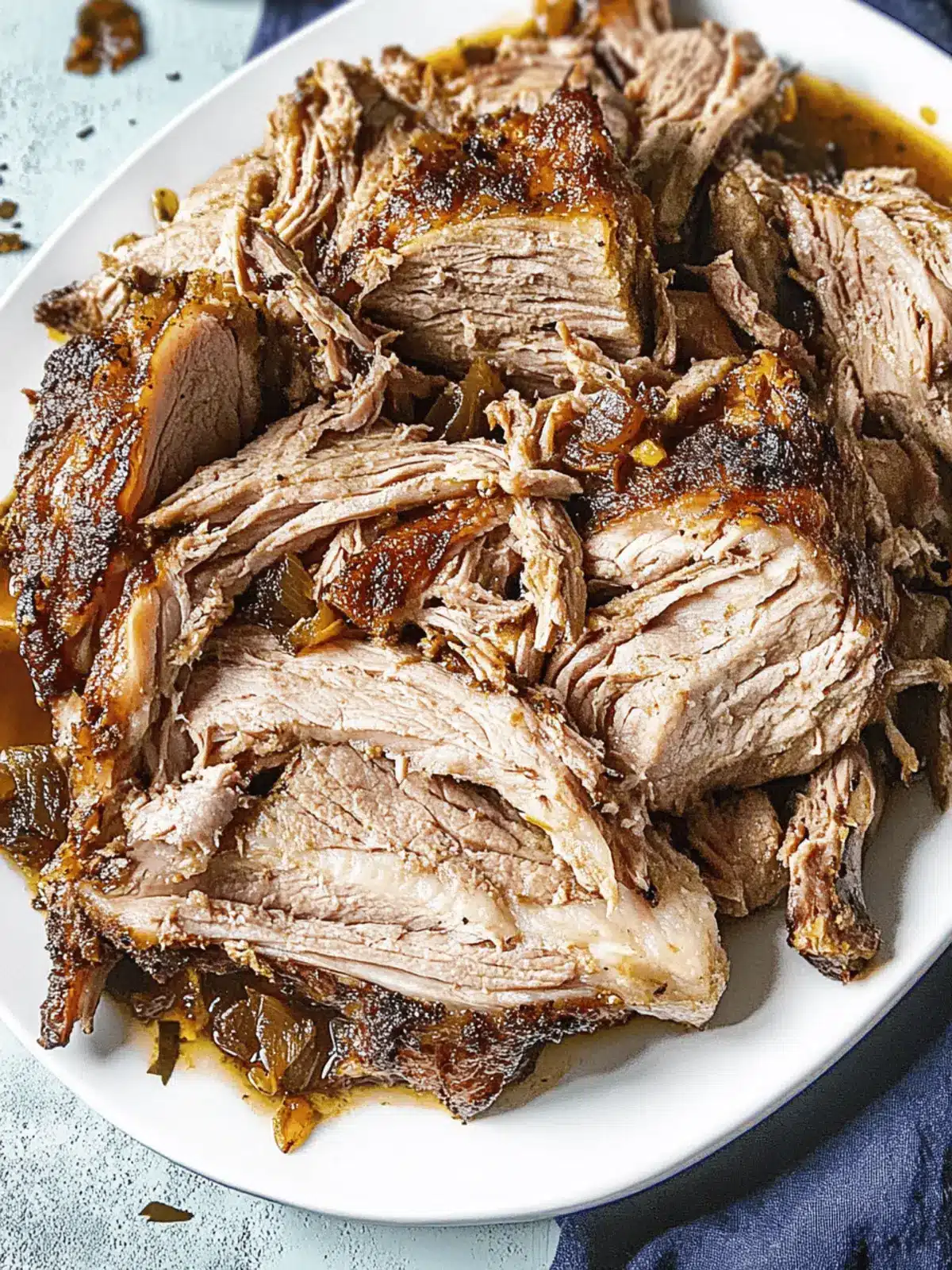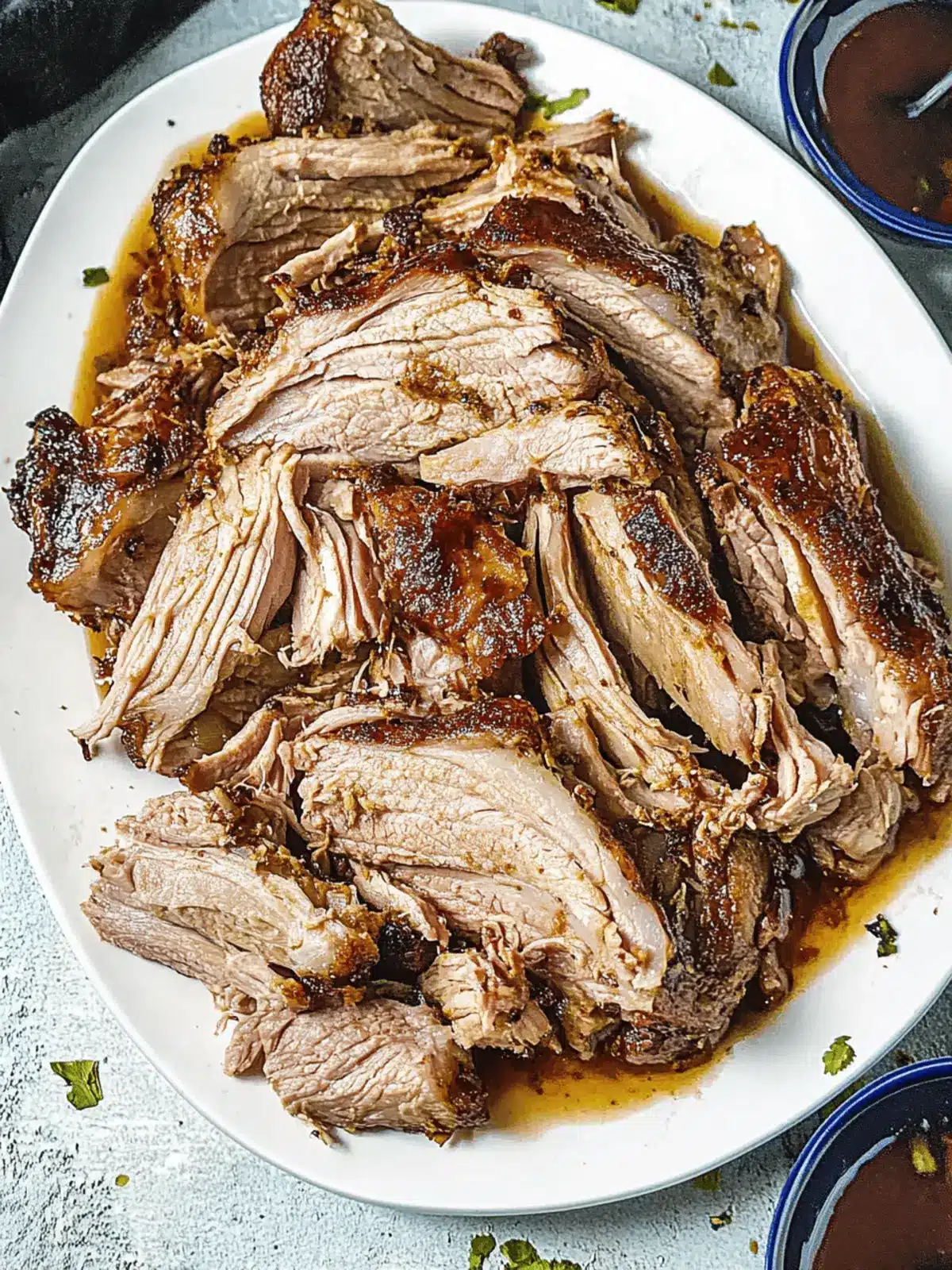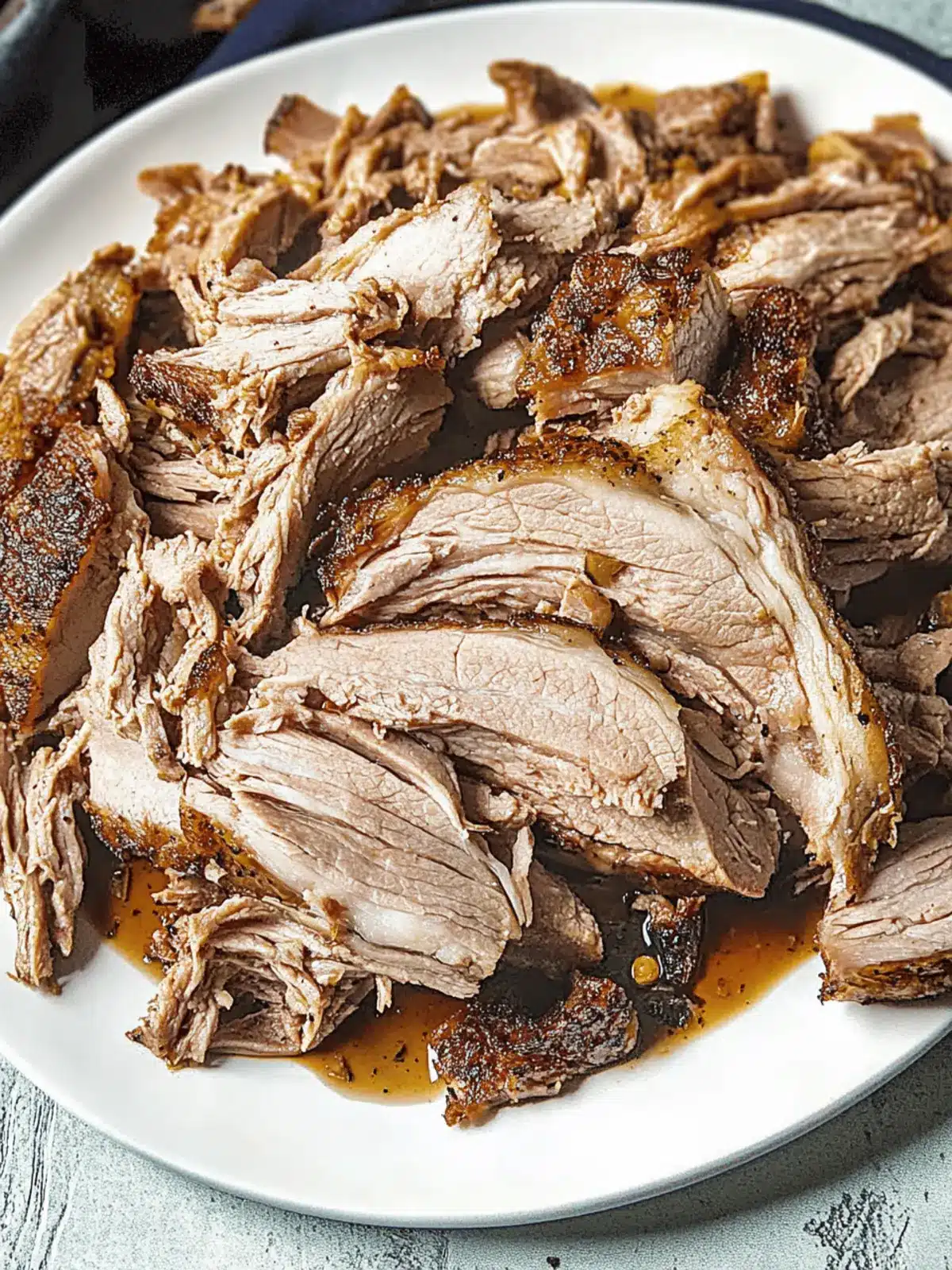There’s a certain joy that comes from the smell of a succulent roast filling your home. As I was preparing for a recent family gathering, I came across my beloved Pernil Recipe (Puerto Rican Roast Pork). The memories of festive celebrations and heartfelt conversations shared over this dish flooded back, igniting my excitement to recreate it.
Imagine the tender pork, perfectly seasoned with fragrant sofrito and zesty sour orange juice, melting in your mouth with every bite. Whether it’s a holiday feast or just a Sunday family dinner, this roast pork promises to be the star of the show. Plus, the beauty of this recipe lies in its simplicity and versatility—perfect for seasoned chefs and home cooks alike who yearn for homemade goodness over the mundane fast-food routine.
Join me as we navigate through the layers of flavors and traditions that make this Pernil not just a meal, but a culinary celebration that warms the heart and brings everyone together.
Why is this Pernil Recipe unforgettable?
Rich, Irresistible Flavor: This Pernil recipe boasts a mouthwatering combination of sofrito and sour orange juice that infuses the pork with incredible depth.
Effortless Preparation: The marinade can be made in a breeze, and with marinating time, you can easily fit this dish into your busy schedule.
Feast for All Occasions: Whether it’s a festive gathering or a cozy family dinner, this roast pork is sure to impress and satisfy everyone at the table.
Tender and Juicy Perfection: Slow roasting allows the pork to become falling-apart tender, enhancing its flavor profile.
Versatile Serving Options: Serve it as a main dish, in tacos, or alongside rice and beans for a complete meal—perfect for your culinary creativity!
Pernil Recipe Ingredients
For the Marinade
• Sofrito – This flavorful base gives the pork a rich depth and aroma.
• Dried Oregano – Adds an earthy note that complements the other seasonings beautifully.
• Garlic Powder – Enhances the garlic flavor without the need for fresh, making it easy for busy cooks.
• Ground Coriander – Offers a citrusy, nutty flavor that brightens the dish.
• Onion Powder – A convenient way to introduce savory notes to the marinade.
• Cumin – Adds warmth and a hint of earthiness to this Pernil recipe.
• Salt and Pepper – Essential for balancing the flavors; adjust to your personal taste.
• Olive Oil – Helps to blend the spices and keeps the pork moist during roasting.
For the Pork
• Pork Shoulder (bone-in, skin on, or boneless) – Offers the best flavor and tenderness for roasting; choose your preference!
• Garlic – Sliced and stuffed into slits for a deliciously aromatic infusion.
For the Cooking Liquid
• Sour Orange Juice – This key ingredient gives that authentic Puerto Rican flavor; blend orange and lime juice if unavailable.
• Water – Adjust as necessary to keep the roast moist throughout cooking.
• Vinegar – Adds a tangy kick that brightens the rich flavors of the pork.
• Cilantro – Freshly chopped, it brings a burst of color and freshness to the dish!
Get ready to create a memorable meal with this Pernil recipe!
How to Make Pernil
-
Combine the sofrito, oregano, garlic powder, coriander, onion powder, cumin, and salt and pepper in a large bowl. Stir in the olive oil until well mixed, then set aside to allow the flavors to meld.
-
Cut various slits into the pork shoulder and stuff the garlic slices into them, ensuring that the flavor infuses deeply throughout the meat.
-
Rub down the pork shoulder with the prepared marinade, ensuring it is coated evenly. Cover and refrigerate for at least 1 hour, but overnight is even better for maximum flavor.
-
Preheat your oven to 300°F, creating the perfect environment for slow roasting the pork shoulder until tender.
-
Transfer the pork shoulder to a roasting pan or large baking dish with the skin side up. Wipe off any excess marinade and moisture from the skin for better crisping.
-
Pour 1 cup of water and 1 cup of sour orange juice into the bottom of the roasting pan. Cover tightly with foil, sealing in the moisture as it cooks.
-
Bake the pork shoulder for approximately 3 hours, allowing the low heat to tenderize the meat beautifully.
-
Increase the oven temperature to 400°F. Rotate the roasting pan for even cooking and carefully remove the foil. Pat the skin dry with a paper towel. Add more water or sour orange juice if needed to maintain moisture.
-
Continue baking for an additional 1-2 hours or until the internal temperature reaches 210°F or the meat is tender enough to be easily pierced with a fork.
-
Crisp the skin by raising the oven temperature to 500°F and baking for an additional 10 minutes. This will give you that desired crunchy texture.
-
Rest the roast for 20 minutes after removing it from the oven. This allows the juices to redistribute, ensuring each slice is perfectly moist and flavorful.
-
Drain the drippings from the roasting pan into a bowl, skim off the excess fat, and stir in the vinegar and chopped cilantro. Add salt to taste and serve as a delicious dipping sauce or gravy alongside your Pernil!
Optional: Serve with warm tortillas or rice for a delightful and complete meal!
Exact quantities are listed in the recipe card below.

What to Serve with Pernil (Roast Pork)?
When you bring this succulent roast into your home, the delight doesn’t have to stop there—transform your feast into a culinary celebration!
-
Fluffy White Rice:
A classic pairing that soaks up the flavorful juices perfectly, creating a comforting base that compliments the savory meat. -
Mango Salsa:
Fresh, juicy mango adds a sweet, tangy contrast to the rich pork. Each bite bursts with tantalizing flavors that will dance on your palate. -
Tostones (Fried Green Plantains):
Crispy on the outside and tender within, these savory bites provide a delightful crunch and balance the tenderness of the Pernil. -
Black Beans:
A hearty side packed with protein. Their earthy flavor melds beautifully with the zestiness of the roast, emphasizing its rich seasoning. -
Cilantro Lime Corn Salad:
Bright and vibrant, this refreshing salad bursts with flavor. The cilantro and lime enhance the overall dish, adding a lively touch. -
Chimichurri Sauce:
Drizzle this vibrant herb sauce over your Pernil for a tangy kick. The fresh garlic and spices mirror the pork’s rich flavor while adding zest. -
Baked Yuca:
Crisped on the outside and fluffy within, these well-seasoned yuca pieces are an excellent alternative to potatoes, complementing the roast’s flavor profile. -
Puerto Rican Tembleque (Coconut Pudding):
For dessert, finish your meal with this creamy coconut treat. Its sweet, smooth texture provides a perfect counterpoint to the savory feast, leaving everyone in sweet contentment.
Each of these delightful options elevates your Pernil experience into a memorable family gathering filled with warmth and flavor!
Expert Tips for Making Pernil
Marinade Magic: Start marinating the pork shoulder overnight if you can for maximum flavor infusion. A last-minute marinade will yield less intense taste.
Skin Crisping: For perfect skin crispness, ensure the skin is completely dry before baking at high heat. This reduces moisture and promotes that crispy texture.
Water Balance: Keep an eye on the water and sour orange juice levels during roasting. If the pan looks dry, add a little extra to prevent drying out the meat.
Temperature Check: Use a meat thermometer to check for doneness; the ideal internal temperature for a juicy Pernil recipe is 210°F.
Resting Time: Don’t skip the resting time! Letting the pork rest for 20 minutes ensures that the juices redistribute, making every slice incredibly tender.
How to Store and Freeze Pernil Recipe
Fridge: Store leftover Pernil in an airtight container for up to 3 days. Ensure it’s completely cooled before refrigerating to maintain its juicy texture.
Freezer: Wrap the Pernil tightly in plastic wrap and then in aluminum foil. You can freeze it for up to 3 months for optimal flavor preservation.
Reheating: Thaw the Pernil overnight in the fridge before reheating. Warm it gently in the oven at 350°F, covered, to retain moisture and tenderness.
Serving Suggestions: Use leftover Pernil creatively! Slice it for sandwiches, shred it for tacos, or serve warm with rice and beans, transforming your meals into delicious treats.
Make Ahead Options
These Pernil recipe marinated wonders are perfect for meal prep enthusiasts! You can prepare the marinade and rub the pork shoulder up to 24 hours in advance; just be sure to refrigerate it to maintain freshness. If you’re short on time, you can marinate the pork for at least 1 hour, but overnight is always better for enhancing flavor. To finish, simply preheat the oven and bake as directed, adding the water and sour orange juice just before placing the pork in the oven. This method not only saves you time on busy weeknights but ensures the pork stays just as juicy and flavorful when serving!
Pernil Recipe Variations & Substitutions
Feel free to make this Pernil recipe your own by trying out some creative twists to suit your taste and dietary needs!
-
Citrus Swap: Replace sour orange juice with a mixture of grapefruit and lemon juice for a tangy alternative.
-
Vegan Option: Substitute the pork shoulder with jackfruit for a plant-based twist that soaks up the marinade wonderfully.
-
Herb Infusion: Add fresh herbs like rosemary or thyme for an aromatic lift that complements the marinade beautifully.
-
Spice it Up: Add chopped jalapeños or a dash of cayenne pepper for a kick of heat that’ll make your taste buds dance.
-
Zesty Marinade: Incorporate lime zest into the marinade for an extra citrusy burst—your palate will appreciate this vibrant addition.
-
Texture Twist: For a crunchier experience, roast some vegetables alongside the pork, like carrots and potatoes, which will soak up all that incredible flavor.
-
Sweet Variation: Mix in some brown sugar or honey to the marinade for a sweet and savory balance that caramelizes beautifully during roasting.
-
Beer Bath: For a rich flavor, use a light beer instead of water in the roasting pan, adding depth to every juicy bite!
Embrace these variations to elevate your Pernil recipe into a personalized masterpiece!

Pernil (Roast Pork) Recipe FAQs
What type of pork is best for this Pernil recipe?
I recommend using a bone-in, skin-on pork shoulder for the best flavor and tenderness. The fat from the skin keeps the meat juicy during roasting, creating that melt-in-your-mouth experience we adore!
How can I tell when the pork is perfectly cooked?
You’ll want to check the internal temperature; it should reach around 210°F for that perfect tenderness. If you don’t have a thermometer, look for the meat to be easily pierced with a fork, indicating it’s ready to fall apart.
Can I store leftovers, and how long will they last?
Absolutely! Leftover Pernil can be stored in an airtight container in the refrigerator for up to 3 days. Make sure it’s cooled completely before placing it in the fridge, allowing it to retain its savory goodness.
Can I freeze the Pernil?
Yes, you can! To freeze, wrap the cooked Pernil tightly in plastic wrap, then in aluminum foil. It will keep well in the freezer for up to 3 months. When you’re ready to enjoy it, be sure to thaw it overnight in the fridge before reheating.
What if the skin doesn’t crisp up?
No worries! If your Pernil skin isn’t as crispy as you’d like, simply turn the oven up to 500°F during the last 10 minutes of cooking. Make sure the skin is dry beforehand, as moisture can hinder that delightful crunch!
Can I adjust the ingredients for dietary restrictions?
Absolutely! If you have dietary considerations, feel free to use a low-sodium soy sauce as a substitute for salt, or omit the vinegar for a milder flavor. Additionally, those with citrus allergies can use apple cider vinegar instead of sour orange juice.

Ultimate Pernil Recipe for Juicy Puerto Rican Roast Pork
Ingredients
Equipment
Method
- Combine the sofrito, oregano, garlic powder, coriander, onion powder, cumin, and salt and pepper in a large bowl. Stir in the olive oil until well mixed, then set aside to allow the flavors to meld.
- Cut various slits into the pork shoulder and stuff the garlic slices into them, ensuring that the flavor infuses deeply throughout the meat.
- Rub down the pork shoulder with the prepared marinade, ensuring it is coated evenly. Cover and refrigerate for at least 1 hour, but overnight is even better for maximum flavor.
- Preheat your oven to 300°F, creating the perfect environment for slow roasting the pork shoulder until tender.
- Transfer the pork shoulder to a roasting pan or large baking dish with the skin side up. Wipe off any excess marinade and moisture from the skin for better crisping.
- Pour 1 cup of water and 1 cup of sour orange juice into the bottom of the roasting pan. Cover tightly with foil, sealing in the moisture.
- Bake the pork shoulder for approximately 3 hours, allowing the low heat to tenderize the meat beautifully.
- Increase the oven temperature to 400°F. Rotate the roasting pan for even cooking and carefully remove the foil. Pat the skin dry with a paper towel.
- Continue baking for an additional 1-2 hours or until the internal temperature reaches 210°F or the meat is tender enough to be easily pierced with a fork.
- Crisp the skin by raising the oven temperature to 500°F and baking for an additional 10 minutes.
- Rest the roast for 20 minutes after removing it from the oven before slicing.
- Drain the drippings from the roasting pan into a bowl, skim off the excess fat, and stir in the vinegar and chopped cilantro. Add salt to taste and serve as a dipping sauce or gravy.






